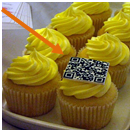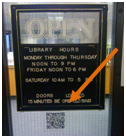What is a QR Code?
You have probably already seen a QR code and didn’t realize what it was. A QR Code, short for Quick Response, is a square shaped, two-dimensional bar code that can contain any combination of alphanumeric text or a URL, which can be read by a Smartphone using a QR code reader. QR codes are currently most popular in Japan, where they were created by Japanese corporation Denso-Wave in 1994 to be decoded at high speed.
In Japan QR codes can be found in many places such as product labels, billboards, on buildings,  and in store windows inviting passers-by to pull out their Smartphone and read the QR code (a practice known as “mobile tagging”) to uncover the encoded information. While Japan remains the epicenter for QR Codes, their popularity is spreading across Europe and the United States, especially with the increasing ease of access to a 3G network via cell phones. Even Good Morning America investigated QR Codes in America.
and in store windows inviting passers-by to pull out their Smartphone and read the QR code (a practice known as “mobile tagging”) to uncover the encoded information. While Japan remains the epicenter for QR Codes, their popularity is spreading across Europe and the United States, especially with the increasing ease of access to a 3G network via cell phones. Even Good Morning America investigated QR Codes in America.
How Do They Work?
“The idea of linking spaces to information is not new, but QR codes combine simple creation with easy access to QR code readers. Data can be translated into a QR code by any QR generator, many of which are available free online. Users simply enter the data to be translated, and the generator produces the code, which can then be  displayed electronically or in printed format.” (7 things you should know about QR codes) Reading a QR code is as easy as creating one. First install a QR Reader, available for free online, onto any Smartphone. Then simply identify a QR code, point your phone’s camera toward the code and scan it using your QR Reader. The QR reader will automatically interpret the code and will either display the code’s text or launch the URL embedded in the code.
displayed electronically or in printed format.” (7 things you should know about QR codes) Reading a QR code is as easy as creating one. First install a QR Reader, available for free online, onto any Smartphone. Then simply identify a QR code, point your phone’s camera toward the code and scan it using your QR Reader. The QR reader will automatically interpret the code and will either display the code’s text or launch the URL embedded in the code.
To learn how JHU is helping to pioneer the academic uses of QR codes, continue reading after the break.
QR Codes at the DC Regional Library Resource Centers
While QR codes are growing in commercial applications, their potential as academic resources has been limited. Bath University in England is leading the charge for academic uses for QR codes. A grant-funded venture led by Andy Ramsden is investigating ways to use QR codes in academic settings. For example: Instructors are using QR codes in their slide presentations to direct students to supplementary information; stickers have been  placed on campus signs to offer GPS locations and mapping for new students lost on campus. QR codes have even been placed on student tests to help ensure anonymity in grading.
placed on campus signs to offer GPS locations and mapping for new students lost on campus. QR codes have even been placed on student tests to help ensure anonymity in grading.
At the DC Regional Libraries, QR codes are being introduced to students as supplemental aids to visual information. For example, the hours of operation are posted on the entrance doors at all libraries, but at the DC Regional Libraries, a QR code is also posted on the door so that students can download the library’s operational hours and contact information directly into their Smartphone. We have also added a QR code for our virtual suggestion box onto the physical suggestion boxes within the libraries. The DC Regional Library Resource Centers are planning to incorporate QR codes into our upcoming summer and fall instruction classes. These are just a few examples of how JHU is helping to pioneer the academic uses of QR codes.
The Future of QR Codes
Whether you find a QR code on your next McDonald’s wrapper, as a link to the online nutritional value of your Big Mac, or in magazines next to a pair of shoes (which will use your GPS location to direct you to the nearest store which has your size in-stock), the numerous commercial applications for QR codes could help kick-start their academic potential. “QR codes link the physical world with the virtual by providing on-the-spot access to descriptive language and online resources for objects and locations. In this way, the codes support experiential learning, bringing scholarship out of the classroom and into physical experience; Finally, the greatest importance of QR codes could lie not in their specific use, which may be superseded by newer codes and interpreters, but in the opportunities they offer for moving away from keyboards as input devices in learning environments.” (7 things you should know about QR codes)
